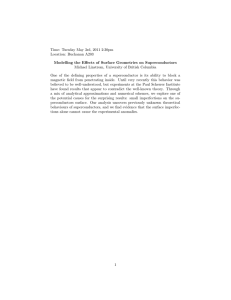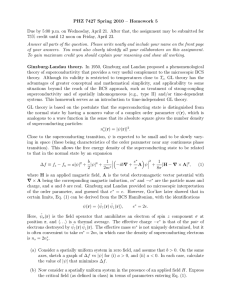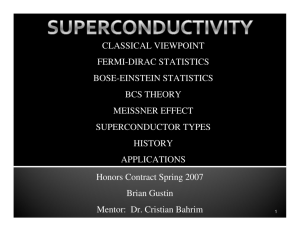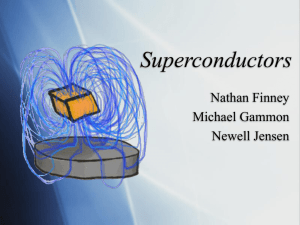QuickField Analysis for Superconductors
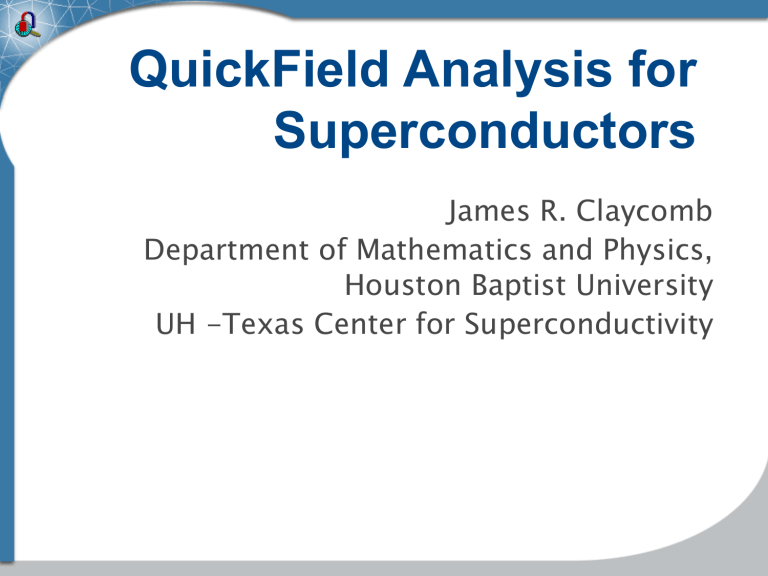
QuickField Analysis for
Superconductors
James R. Claycomb
Department of Mathematics and Physics,
Houston Baptist University
UH -Texas Center for Superconductivity
QuickField Analysis for
Superconductors
Superconductivity Basics
Specifying Superconductors in QuickField
Superconducting Plates
Hollow Superconducting Shells
Inductance Calculations
Flux Trapping
Superconducting Magnetic Levitation
Nonlinear B-H Characteristics of Superconductors
Coupled Magnetostatic and Stress Analysis of Superconductors
Superconducting vs. Permeable Magnetic Shields
Superconductivity Overview
Superconductivity is a macroscopic quantum phenomenon where superconducting electrons are described by a single wavefunction in the bulk of the superconductor
Zero electrical resistivity below a critical transition temperature
T c.
External magnetic fields are expelled from superconductors
(Meissner effect).
The superconducting state is abolished by sufficiently high magnetic fields and currents.
The Meissner Effect
London’s equations predict that magnetic flux is expelled from the interior of a superconductor except for thin layer.
The superconductor exhibits perfect diamagnetism.
Modeling Superconductors in QuickField Modules:
Magnetostatics
AC Magnetics
Transient Magnetics
Specifying superconducting regions
The appropriate boundary condition is zero normal flux density on simply connected superconducting surfaces.
This condition can be applied implicitly by choosing the relatively permeability of the superconductor to be nearly zero ( r
<<1).
For hollow superconductors, the appropriate boundary condition depends on whether the superconductor is field cooled or cooled in zero magnetic field.
Superconducting strip in an external field B-field
A superconducting strip can be modeled as a single boundary with zero normal magnetic field
( )
( )
Superconducting Sphere in an External B-field
Modeled using (1) near zero permeability (2) boundary conditions
Once the field is calculated, the supercurrent density at the surface of the superconductor may be determined by the discontinuity in the tangential component of the field strength H t
Hollow Superconducting Shells
Field-Cooled (FC) boundary condition: normal B equal zero on the superconductor
– flux penetrates the opening of the superconductor
Zero-Field-Cooled (ZFC) boundary condition: zero vector potential specified on the superconductor – flux is expelled from the opening
Superconducting Rings (top view)
surf
B da
A d
Calculation of Inductance
The inductance
L of a superconductor is calculated from
app
LI
Applied Flux
app
surf
B
d a
Total supercurrent
0
I
d
B
Type I and Type II Superconductivity
Type-I superconductors, such as lead, become normal in magnetic fields greater than the thermodynamic critical field h with increasing temperature. c which decreases
Type-II superconductors such as Nb characterized by two critical fields
Flux is expelled from the superconductor below h h
3 c1
Sn are
and c1
and the sample becomes normal above h h c2
. c2
.
Modeling nonlinear B-H characteristics
-M h c1 h c h c2
Magnetization curves for Type I (----) and
Type II (___)superconductors
c
h
0
1
2
Modaeling Field Penetration in
Superconductors
(a) (b) (c)
Flux penetration into a superconductor with a nonlinear B-H curve for
(a) B=0.07 T (b) B=0.2 T (c) B= 0.7 T
Layered Superconducting and
Permeable Shields
Permeable plate surrounded by two superconducting plates in a transverse B-field
By Jones and Bartlett Learning

